There are hunting opportunities on more than 85 percent of the land base in Alberta’s parks system. Hunting is permitted in all Wildland Provincial Parks and some Provincial Parks and Provincial Recreation Areas under the Provincial Parks Act.
Alberta Parks are enjoyed by a wide range of recreational users year-round and in Provincial Parks and Provincial Recreation Areas, where hunting is allowed, Firearm Discharge Permits are required to address public safety and inform hunters of areas where discharge is prohibited because of site specific values and facilities.
Cooking Lake-Blackfoot is designated as a Provincial Recreation Area and is managed by Alberta Forestry and Parks. This site holds a long and rich history in the Beaver Hills area of the province, and is now a part of the UNESCO Beaverhills Biosphere and Beaver Hills Dark Sky Preserve – it is an important and valued natural landscape. Forestry, agriculture, Indigenous land use and general recreation have all helped to shape this landscape and continue to thrive here to this day. As a multi-use recreation area, there are a great number and variety of users found within the site’s boundaries. It is important to respect these user groups while enjoying the land base yourself.
Hikers, cyclists, equestrian users, school children and hunters, as well as cattle ranchers and even oil and gas disposition holders are present at all times of year at Cooking Lake-Blackfoot. Please be aware of their presence and take appropriate measures to ensure you are being safe and aware at all times.
Over 170 km of trails wind through the recreation area, exposing users to wetlands, pastures and dense forest. Wildlife thrives here and biodiversity among both animal and plant life is high. Please be respectful of the land and those that call it home. Do not damage or remove anything from the recreation area, with the exception of the animal you are permitted to take.
Cooking Lake-Blackfoot sees high visitation and is a favorite location for many local residents and visitors (both human and animal). In order to ensure everyone is able to enjoy the area safely, Alberta Parks requires discharge permits to be obtained and this online course to be reviewed by anyone wishing to hunt within the recreation area. We appreciate your participation and cooperation in continuing to keep Cooking Lake-Blackfoot a safe and welcoming destination.

Cooking Lake-Blackfoot Provincial Recreation area has 4 main staging areas: Waskahagen, Islet Lake, Central and Blackfoot Staging Area.
Hunters may also access the park from Range Road 204, 203, 202, Henry Wood Road along the parks east boundary (Church Gate). See provided maps for more details.
Head north on RR 203 and arrive at a dead end and private residence gate. Please do not enter private residence gate. Park here but please be sure to stay out of way of access for private residents.
When you exit the vehicle go right and go over stairs at post. Follow trail to the north where you will eventually reach the fence and access ladder, however 30 yards NW of the ladder there is a wildlife gate that provides easier access.
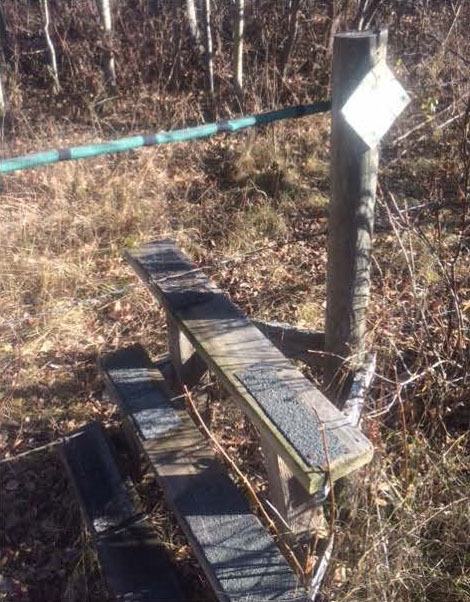 Waskahegan #1 stairs for getting over the barbed wire fence
Waskahegan #1 stairs for getting over the barbed wire fence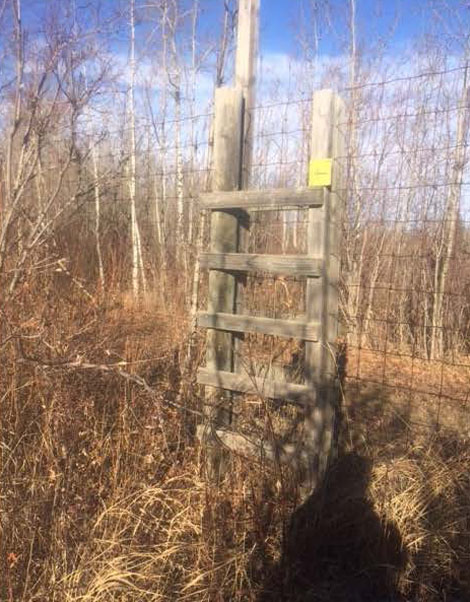 Waskahegan #2 access ladder
Waskahegan #2 access ladder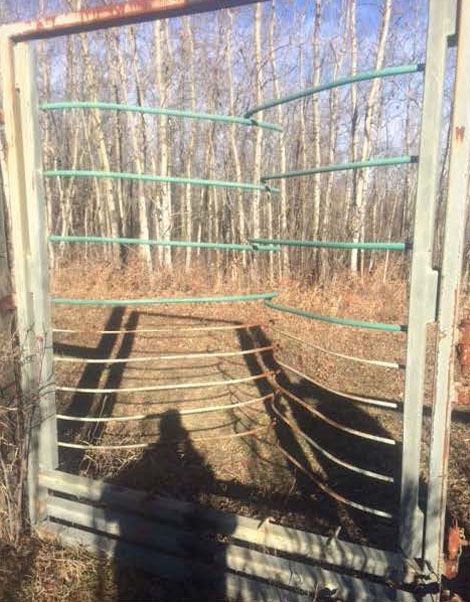 Waskahegan #3 wildlife gate
Waskahegan #3 wildlife gateHeading north on RR 192 there is a sign indicating Henry Wood Road turn left down it and it is a dead end road – be aware there are private residences along the way and travel cautiously.
Please do not block the gate and ensure it is secure at all times.
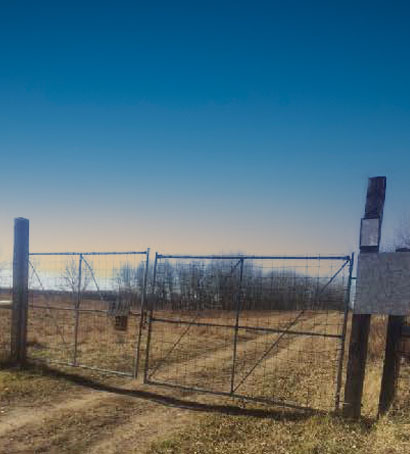 Church gate #1, service vehicle gate
Church gate #1, service vehicle gate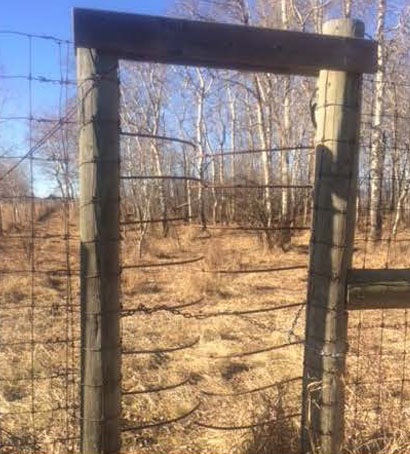 Church gate #2, wildlife gate
Church gate #2, wildlife gate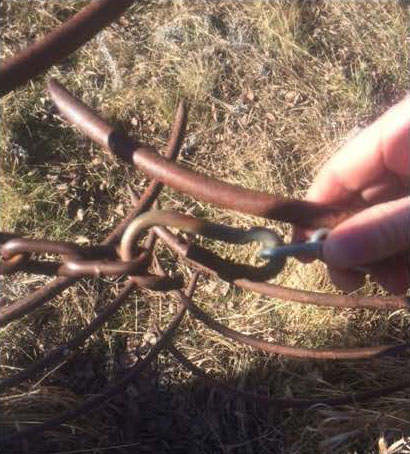 Church gate #3 gate hook. Please ensure gate is tight and shut after every use. Please hook it back up and do not leave it open.
Church gate #3 gate hook. Please ensure gate is tight and shut after every use. Please hook it back up and do not leave it open.Hunters should use caution and be aware that there are many predators in the area including Coyotes, Gray Wolf, Black Bear and the occasional Cougar. Should it be necessary to leave your animal overnight, be sure to drag the offal (organs) away from the carcass as these predators/scavengers will typically consume those parts first.
Please report any animal harvested with an ear tag to Conservation Officers upon discovery. Ear tags may be white with black numbers, or orange stating “DO NOT EAT” followed by a phone number. The “do not eat” tag is placed on animals that have been tranquilized; hunters must tag their animal and can still expect to salvage their harvest, but depending on when the animal was tranquilized, the hunter will find out whether the meat is safe to consume (or whether a replacement tag may be issued).
Cooking Lake-Blackfoot PRA has a 24-hour Chronic- Wasting Disease freezer drop off location for hunters to drop off deer heads for testing during fall rifle seasons. Please refer to the attached poster and Chronic Wasting Disease – Information for Hunters for further information.
Hunters ensure that populations stay at a healthy and at a sustainable level, reporting your harvest allows for park staff to monitor populations and gain knowledge of the number of animals coming out of WMU 936.
To determine sex and species it is pertinent a hunter is familiar with the Alberta Guide to Hunting Regulations regarding identification and regulations.
Waterfowl hunters should be aware that swans nest in the park. Ensure you can identify the differences between a snow goose and swan (especially during flight). Please refer to the Alberta Guide to Hunting Regulations for Snow Goose and Swan Identification tips.
Confirmed Swan breeding pairs are located throughout the park. Please be vigilant with identification around Running Dog Lake, West Sawmill Lake, Islet Lake, Blackfoot Lake, Coyote Lake, Geese & Bog Lake, and Muskrat Lake.
The Snow Goose has black wing tips and Swans have white wing tips with a longer neck.
Supplemental antlerless white-tailed deer licences cannot be used in WMU 936.
There is no hunting season for Mule Deer in WMU 936.
Please refer to the Alberta Guide to Hunting Regulations for Mule Deer and White-tailed Deer Identification tips.
First Nations or Métis who hold treaty hunting rights or are registered harvesters please refer to Indigenous hunting and fishing in Alberta for treaty rights in Alberta.
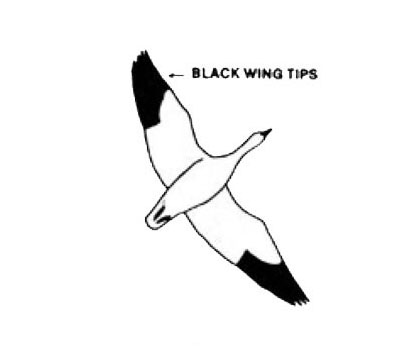 Snow Goose
Snow Goose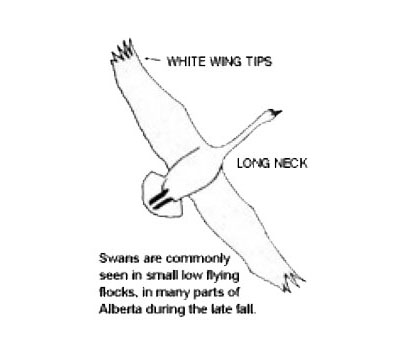 Swan (Do Not Shoot)
Swan (Do Not Shoot)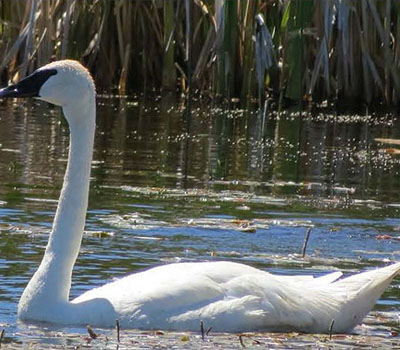 Swan.
Swan.Cooking Lake -Blackfoot Provincial Recreation Area (WMU 936) borders Elk Island National Park along the northwest. Hunting in a National Park carries fines up to $250,000 and/or 5 years in prison. Please be cautious and take the time to know where you are hunting in WMU 936. Please refer to the maps.
There are areas of Cooking Lake-Blackfoot Provincial Recreation Area that are outside of the seven foot ungulate fence. Take the time to know where you are and please ensure that you are not hunting on national park property.
Any barbed wire boundary fences will be marked with yellow “Provincial Recreation Area” signs. Please contact Alberta Fish and Wildlife for more information.